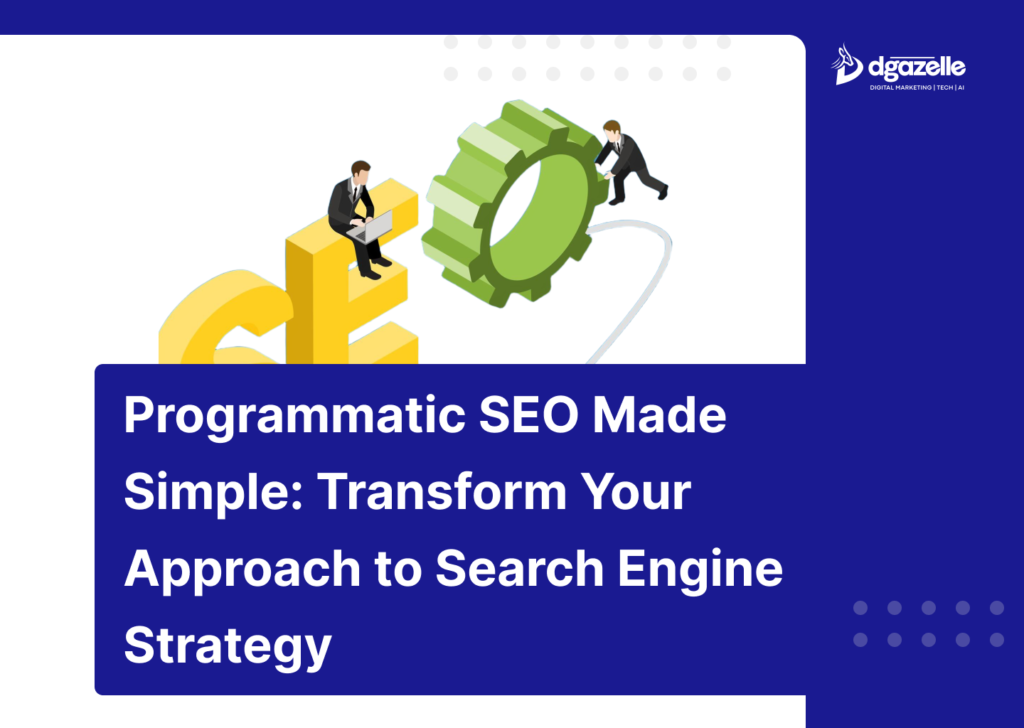Ever wondered how some websites effortlessly rank for thousands of keywords without a huge content team? That’s the magic of programmatic SEO.
With AI increasingly on the rise, automation are game-changers. Programmatic SEO empowers businesses to generate hundreds—even thousands—of optimized pages at scale, saving valuable time while driving significant search visibility. Instead of relying solely on manual tactics, it uses data-driven insights to spot trends, automate optimization, and boost results.
But here’s the catch—it’s not for everyone. To unlock its full potential, you need a clear strategy tailored to your business goals.
Looking to outsmart your competitors with smarter, scalable SEO tactics? Partner with our digital marketing experts to craft a winning programmatic SEO strategy designed to amplify your search rankings and drive growth.
What is Programmatic SEO?
Programmatic SEO is an approach to search engine optimization that uses automation to create large numbers of pages, each targeting specific, low-competition keywords. For instance, travel aggregator sites like Expedia effectively use programmatic SEO by generating location-specific pages for flights, hotels, and tourist activities based on structured data. Unlike traditional SEO, where content is manually crafted for each keyword, programmatic SEO relies on templates and automation tools to generate hundreds—or even thousands—of pages at scale. This method is particularly useful for businesses offering a wide range of products, services, or content topics.
What’s made programmatic SEO even more accessible today is the rise of AI and automation tools like GPT-4, Frase, and SurferSEO. GPT-4 helps generate detailed base content efficiently, Frase aligns it with user intent to improve engagement, and SurferSEO provides data-driven keyword insights to optimize content performance. When executed with the right data and automation setup, programmatic SEO can drive serious traffic at scale.
Summarizing the advantages of automation and data-driven insights, it’s important to acknowledge potential downsides. Programmatic SEO isn’t for everyone. It works best for websites that provide unique, relevant data across a large set of similar keywords. Without quality data and a clear strategy, thin, low-value content can harm your rankings instead of boosting them. To mitigate this risk, prioritize high-quality content by using robust templates, incorporating user-focused information, and maintaining data accuracy.
Programmatic SEO vs. Traditional SEO
The key difference between programmatic SEO and traditional SEO lies in execution and scalability—both of which have implications for small and medium-sized enterprises (SMEs). Traditional SEO focuses on crafting high-quality, targeted content for individual keywords through meticulous user research, manual content updates, and in-depth optimization. This hands-on approach aims to satisfy search intent for highly specific queries, often requiring significant time and creative resources.
On the other hand, programmatic SEO is designed for efficiency and scale. Instead of manually creating pages for each keyword, businesses develop templates and use automation to generate hundreds or even thousands of pages targeting long-tail keywords. This approach works particularly well for SMEs managing diverse product catalogs, service directories, or niche content categories.
For example, an SME running an e-commerce store can use programmatic SEO to create dynamic product pages that incorporate essential elements like pricing, customer reviews, and specifications. Similarly, a real estate directory can generate location-specific listings by leveraging structured data.
Both approaches hinge on strong keyword research—without it, any SEO effort will falter. However, programmatic SEO requires additional attention to data accuracy and content quality to prevent thin, low-value pages. SMEs adopting this strategy should ensure their content templates provide meaningful user experiences and valuable information.
Here’s a refined version of the “Potential Benefits of Programmatic SEO” section optimized for SEO and SME business owners:
Benefits of Programmatic SEO
One of the most impactful advantages of programmatic SEO is its efficiency. For SMEs with limited time and resources, this approach offers a way to generate a vast number of keyword-focused pages without the heavy cost of manual content creation. Automation allows you to scale up and create hundreds or even thousands of pages quickly, saving valuable time and operational expenses.
This approach also helps capture organic traffic that competitors might overlook by targeting low-competition, niche keywords. For example, a local service provider or product-based business can create pages optimized for specific locations or services, expanding their reach and authority across multiple regions.
Moreover, programmatic SEO boosts your website’s visibility. By increasing the number of indexed pages, businesses gain more opportunities to appear in search results, attract new customers, and establish their online authority. When executed strategically, it can complement traditional SEO efforts and maximize your site’s organic growth potential.
How to Set up Programmatic SEO
Now that you’re familiar with programmatic SEO, let’s break down an actionable, step-by-step process to help SMEs efficiently scale their search visibility. With the right approach, this method becomes manageable and highly rewarding.
1. Identify Strategic Keywords
Effective programmatic SEO begins with smart keyword research. Identify niche, low-competition long-tail keywords relevant to your industry. Tools like Ubersuggest or SEMrush are valuable for generating keyword lists. For SMEs, focus on terms with high purchase intent or location-based searches, such as “affordable marketing services in [city]” or “best digital tools for [sector].”
2. Create Flexible Page Templates
Develop a template for dynamic page creation. Keep it clean and user-friendly, with placeholders for elements like product prices, service descriptions, or city-based content. This template becomes the framework for generating multiple SEO-optimized pages while maintaining consistent branding and functionality.
3. Leverage High-Quality Data Sources
Accurate, relevant data elevates your pages. SMEs can use internal databases, publicly available datasets, or carefully vetted external sources to populate dynamic content fields. Ensure your data stays up to date—whether it’s pricing, locations, or service descriptions—to maintain user engagement and search relevance.
4. Automate Page Generation
Automation is the heart of programmatic SEO. Use tools like Google Sheets combined with WordPress plugins (e.g., WP All Import) or Webflow to dynamically populate page templates. This process can help SMEs create hundreds of keyword-focused pages quickly, without sacrificing consistency or functionality.
5. Optimize and Improve Continuously
Automation doesn’t mean set-and-forget. Regularly review metrics like bounce rate, average time on page, and CTR to identify areas for improvement. If engagement is low, revisit keyword relevance, content clarity, or page structure. Additionally, analyze conversion rates to ensure pages are delivering tangible business outcomes.
Conclusion
Exploring programmatic SEO can transform how SMEs scale their search presence, but there are no shortcuts. While automation saves time, quality remains non-negotiable. Each page must provide genuine value to your audience.
Ensure your content marketing is solid, optimize regularly, and establish a clear SEO strategy before diving in. Programmatic SEO isn’t a substitute for traditional SEO; they complement each other, working together to maximize visibility and engagement.
With the availability of user-friendly and cost-effective tools, there’s no better time to try programmatic SEO. Begin with thorough keyword research—arguably the most critical step. Nail down your head terms and modifiers, and you’re on your way to creating a winning SEO strategy.
Unlock the power of programmatic SEO and strategic digital marketing tailored for your SME. Our experts help you rank higher, attract quality traffic, and convert leads into loyal customers. Let’s Scale Smarter, Not Harder!







